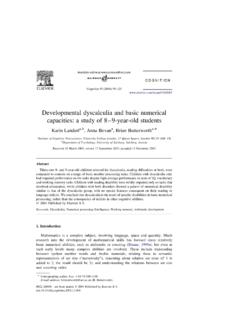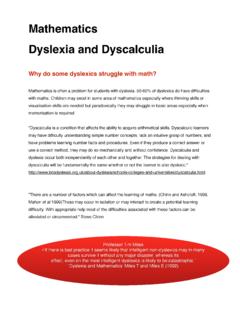Transcription of Basic Mathematics Notes - Home: Earth and …
1 Basic MathematicsContents1 Basic Questions ..22 Linear and Vectors .. by a scalar .. of two matrices .. for matrix-matrix multiplication .. multiplication .. Matrices .. Scalar products and orthogonality .. Systems .. determinants to invert a2 2matrix .. and Eigenvectors .. 153 Differentiation and .. Results .. rule .. rule .. rule .. points in 1D .. derivatives .. points in 2 dimensions .. Series .. Integrals .. 294 Complex .. concept .. Plane .. Form .. Notation .. Application to waves .. Amplitude and phase .. Complex solution to the wave equation .. 435 Error Notation .. of errors .. with worst case scenario? .. Distribution .. limit theorem .. Intervals .. 4911 Basic SkillsThis document contains Notes on Basic Mathematics . There are links to the corresponding LeedsUniversity Libraryskills@Leeds page, in which there are subject Notes , videos and you require more in-depth explanations of these concepts, you can visit the Wolfram Math-world website: Wolfram link( ) Algebra (Expanding brackets, Factorising) : Library link( ).
2 Fractions : Library link( ). Indices and Powers : Library link( ). Vectors : Library link( ). Trigonometry and geometry : Library link( ). Differentiation and Integration : Library link( ). Practice QuestionsThere are practice equations available online to accompany these Linear Algebra Wolfram link( ) Matrices and Vectors Library link( ) DefinitionsA matrix is a rectangular array of numbers enclosed in brackets. These numbers are calledentries orelements of the 1360 1 4 (1)MatrixAhas 2 rows and 3 is a matrix with a single [1 3 6](2)Whereas acolumnvector is a matrix with a single 10 (3)The size of a matrix is defined byn mwherenis the number of rows andmis the numberof columns. MatrixA, as defined in equation 1, is a2 element of a matrix can be described by its row position and column position. For ex-3ample: the top left element in matrixA, equal to 1, is in row 1 and column 1 and can belabelled as elementa11; the element in the 2ndcolumn of row 1, equal to 3, is labelled general elementaijis located in rowiand columnj(see equation 4 for a further example).
3 NotationThere are different types of notation for matrices and vectors that you may encounter in textbooks. Below are some examples:MatrixAitalicsAbold, italicsAdouble underline, italicsVectorxitalics~xtop arrow, italicsxsingle underline, Addition Wolfram link( ) Video link( )Two matrices (or vectors) of the same size (n m) may be added together, element byelement. For instance, if we have two matricesAandB:A= a11a12a21a22 B= b11b12b21b22 (4)4then,A+B= a11+b11a12+b12a21+b21a22+b22 (5) SubtractionSimilar to addition, corresponding elements inAandBare subtracted from each other:A B= a11 b11a12 b12a21 b21a22 b22 (6) Multiplication by a scalarIf is a number ( a scalar) andAis a matrix, then Ais also a matrix with entries a11 a12 a21 a22 (7) Multiplication of two matrices Wolfram link( )This is non-trivial and is governed by a special rule. Two matricesA, whereAis of sizen m, andBof sizep q, can only be multiplied ifm=p, the number of columns inAmust match the number of rows inB.
4 The matrix produced has sizen q, with each entrybeing the dot (or scalar) product (see section ) of a whole row inAby a whole column ifA= 1360 1 4 andB= 1 235 679 10 11 (8)thenAB= (1 1)(1 2)(1 3)+ (3 5)+ (3 6)+ (3 7)+ (6 9)+ (6 10)+ (6 11)(0 1)(0 2)(0 3)+ ( 1 5)+ ( 1 6)+ ( 1 7)+ (4 9)+ (4 10)+ (4 11) = 70 80 9031 34 37 Formally, ifAB=Cthencij=m k=1aikbkj(9)AsideWhen using Matlab (or octave), two matrices can be multiplied in an element-wise sense. Thisis NOTthe same as described Motivation for matrix-matrix multiplicationTo understand why we may need to perform matrix-matrix multiplication, consider two cus-tomers of a repair garage, Peter and Alex, who require a number of car parts for each of theirvehicles. Peter requires1 3litre engine and 2 doors, whereas Alex requires1 5litre engineand 4 doors. All the parts require a certain number of screws and bolts. But how many totalscrews and bolts do Peter and Alex need?We can present the quantity of each car part that Peter and Alex need in a table:3 litre engine 5 litre engine DoorsPeter102 Alex014or as the matrix,A:A= 1 0 20 1 4.
5 (10)The number of screws and bolts for each car part are expressed in the table:bolts screws3 litre345 litre18doors21or can be expressed as matrix,B:A= 3 41 82 1 .(11)Using simple addition we can find out how many screws and bolts are How many bolts are needed for Peter s car parts?(1 3) + (0 1) + (2 2) = How many bolts are needed for Alex s car parts?(0 3) + (1 1) + (4 2) = How many screws are needed for Peter s car parts?(1 4) + (0 8) + (2 4) = we can use matrix multiplication to get all four scenarios:AB= 1 0 20 1 4 3 41 82 1 = 7 69 12 Matrix-vector multiplicationSince a vector is a special case of a matrix, this is simply a special case of the matrix-matrixmultiplication we have already discussed. Consider multiplying a column vector of lengthmby a matrix of sizen m, 1360 1 4 213 = 2311 which results in a column vector of lengthnand in this casen= Special MatricesIdentity Matrix,I:The identity matrix,I, of sizen n, is defined in equation 1ifi=j0ifi6=j(12) ifn= 2I= 1 00 1 (13)This is a special case of a diagonal matrix possessing non-zero entries only on its diagonal 2 000 300 0 1 IfAis a squaren nmatrix, then the identity matrixIn nhas the special property that:AI=IA=A(14)NB:Iis the equivalent of 1 in scalar arithmetic 2 = 2 1 = ,AT:IfAis an mmatrix then the transpose ofA, denotedAT, is am nmatrix found by swapping rows and columns ofA, 1360 1 4 AT= 103 164 Inverse matrix,A 1 IfAis ann nmatrix, sometimes (see later) there exists another matrixcalled the inverse ofA, writtenA 1, such thatAA 1=A 1A=I(15)NB.
6 For scalar numbers,x 1is the inverse ofxwhen considering multiplication, sincexx 1=x 1x= 1(16)9 Clearly whenx= 0this breaks down andxhas no inverse this is also true when dealingwith some Scalar products and orthogonalityThe scalar product (or dot product, or inner product) of two column vectors of lengthn, wherex= (x1,x2,x3,..xn)andy= (y1,y2,y3,..,yn), isx y=n i= can also be written asxTy; that is, the product of a row vector of lengthnwith a columnvector of lengthn. Two vectors are said to be orthogonal if their scalar product is Linear Systems Wolfram link( ) Video link( )A linear system of equations such as5x+ 3y+z= 32x 10y 3z= 14y+ 5z= 7(17)can be written as 5312 10 3045 xyz = 3 17 as can be verified by multiplying out the left hand side. When solving the linear systemAx=b,(whereAis a matrix,xis the vector(x,y,z,..)andbis a vector of numbers) two cases canarise:i)A 1Ax=A 1b Ix=A 1bsox=A 1bii)A 1doesn t exist. There is then no solution in Determinants Wolfram link( ) Video link( )How do we know whenA 1exists?
7 One method is to calculate the determinant ofA, writ-ten detAor|A|. The determinant is a single number that contains enough information aboutAtodetermine whether it is 2 determinants:In the2 2case, ifA= a bc d then|A|=ad bc. For example, for the linear system given byx+ 2y= 23x+ 4y= 3the determinant of the coefficient matrix is 1 23 4 = 4 6 = 26= 0(18)The matrixAis therefore invertible (see section ) and so the solution another example, considerx+ 2y= 22x+ 4y= 312 The determinant of the coefficient matrix is 1 22 4 = 4 4 = 0(19)Therefore,Ahas no inverse and so no solution exists. This can also be seen in the fact thatit is not possible thatx+ 2ysimultaneously equal 3 determinants:Determinants can be generalised ton nmatrices. For the3 3matrixA,A= a11a12a13a21a22a23a31a32a33 the determinant ofAis:|A|=a11 a22a23a32a33 a12 a21a23a31a33 +a13 a21a22a31a32 or equivalently,|A|=a11 a22a23a32a33 a21 a12a13a32a33 +a31 a12a13a22a23 1 0 02 3 45 6 7 = 1 3 46 7 = 21 24 = 313or 1 0 02 3 45 6 7 = 1 3 46 7 2 0 06 7 + 5 0 03 4 = 3Do whichever is easier!
8 Using determinants to invert a2 2matrixThe determinant can be used in finding the inverse of a2 a bc d , the inverse can be found using the formulaA 1=1detA d b c a =1ad bc d b c a (20)For example:find the inverse of matrixB= 1 23 4 .B 1= 1 23 4 1=1 2 4 2 31 = 2132 12 . Eigenvalues and Eigenvectors Wolfram link 1( ) Wolfram link 2( ) Video link( )Often we are interested in whether a matrix can stretch a vector. In such a case:Av= v ,(21)where is the stretch factor . The scalar is called aneigenvalue (from the German: eigenmeaning same) andvis vis equivalent to:(A I)v= 0.(22)Ifdet(A I)6= 0then the system can be solved to findv= (A I) 10 = 0. If we wantnon-zero vectorsv, then we require|A I|= find the eigenvectors and eigenvalues, we use a two stage process:i) Solve|A I|= 0,ii) example:A= 14 105 1 i) The eigenvalues are such that 14 105 1 1 00 1 = 015or 14 105 1 = 0or(14 )( 1 ) ( 10)(5) = 0 2 13 + 36 = 0 ( 4)( 9) = 0so = 4or = 9ii) Now to find the eigenvectors,v:If = 4then(A 4I) xy = 0or 10 105 5 xy = 0 x=yHence the eigenvector is:(xx)=x(11), ory(11), or just(11), (see below).
9 If = 9, then 5 105 10 xy = 00 sox= 2ygiving the eigenvector of(2yy)or just(21).The eigenvectors provide a direction and so we can ignore common factors. This is becauseifvis an eigenvector, then so is vfor any value of . v A( v) = ( v).16 For example: if = 4above, then(11),(22),(44)are alleigenvectors. We typically choose thesimplest!Matrix diagonalisationSupposeAis an nmatrix. Form a new matrixV, each column ofwhich is an eigenvector ofA. IfV 1exists then,V 1AV= orA=V V 1where is a diagonal matrix with( 1, 2,..),the eigenvalues ofAon the 14 105 1 thenV= 1 21 1 , = 4 00 9 NB - Eigenvector 1 is:(11), eigenvector 2 is:(21)It turns out thatV 1exists and is:V 1= 121 1 Check:V V 1= 1 21 1 121 1 = 1 00 1 So then the matrix productV 1AV= 121 1 14 105 1 1 21 1 = 121 1 4 184 9 = 4 00 9 17is equal to the matrix .Special case: Symmetric matrixA matrixAis symmetric ifA=AT. It turns out that, inthis case, all the eigenvectors are orthogonal, ifV1andV2are different eigenvectors, thenV1 V2= each eigenvector is normalised such thatVi Vi= 1, then,VT=V 1(This is an easy way to findV 1).
10 Example:A= 1 22 1 (AT=A)Eigenvectors are given by:(1 )2 4 = 0 2 2 3 = 0or( 3)( + 1) = 0so, = 3or = 1 = 1: 2 22 2 xy = 00 x+y= 0 Hence, eigenvector is:(1 1).But this can be normalised (since it s magnitude is arbitrary) by any number : (1 1).Let s choose such that:vTv= 1,wherev= (1 1). 1 = 2(1 1) 1 1 = 2 , 2=12or =1 2 Our normalised eigenvector is then1 2(1 1). = 3: 222 2 xy = 00 2x+ 2y= 0or,x=yHence, eigenvector is (11).Normalise such thatvTv= 1, so 2(1 1)(11)= 1 =1 2as normalised eigenvector is then1 2(11).Define:V=1 2 11 1 1 , = 1 003 19 Then we can check thatV V 1=1 21 2 11 1 1 1 003 1 111 =12 1 313 1 111 = 1 22 1 =AWhy is this useful?Example:What isA8? Using the matrix diagonalisation,A8=(V V 1)(V V 1)(V V 1)(V V 1)(V V 1)(V V 1)(V V 1)(V V 1)=V (V 1V) (V 1V) (V 1V) (V 1V) (V 1V) (V 1V) (V 1V) (V 1V)V 1=(V 8V 1).and 8is an easy matrix to raise to a power: 1 003 8= 1 00 38 (23)This method is much easier than multiplying the matrix by Differentiation and Integration Library link( ) Differentiation Wolfram link( )Suppose the functionf(t)gives distance as a function of time as shown in Figure speedAtdistanceFigure 1At point A, the sketched tangent gives the instantaneous rate of change of distance withtime or calculate the speed (or gradient function) at any time, we approximate the tangent by con-necting two neighbouring points:f(t)andf(t+h)(see Figure 2).







